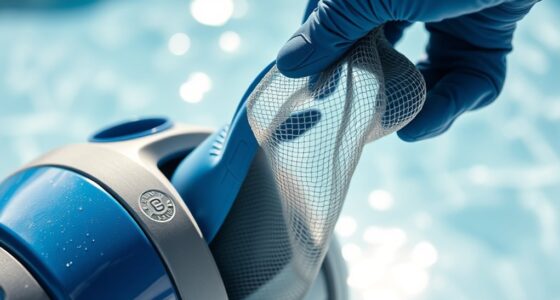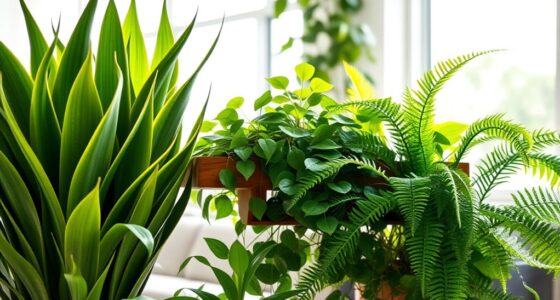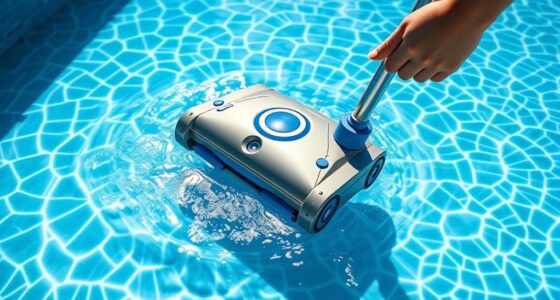Even with automatic cleaners handling most debris, you still need to skim surface debris daily to prevent clogging and algae growth. Check and adjust chemical levels regularly for water balance and safety. Clean pool walls and floors manually to remove stubborn dirt or algae buildup, and inspect equipment like pumps and filters for wear. Managing water levels and ensuring proper circulation help prevent damage. Keep up with these tasks to maintain a safe, clean pool—more tips follow.
Key Takeaways
- Regularly remove surface debris and monitor water levels to prevent clogging and ensure proper skimmer operation.
- Test and adjust chemical levels, including pH and sanitizer, to maintain water balance and prevent algae growth.
- Manually clean walls, floors, and waterline areas to remove algae, dirt, and stains that automatic cleaners might miss.
- Inspect and maintain pool equipment such as pumps, filters, and skimmers for leaks, wear, and proper functioning.
- Conduct visual inspections for cracks, leaks, or water loss, and ensure proper water circulation and leak prevention measures.
Skimming Surface Debris
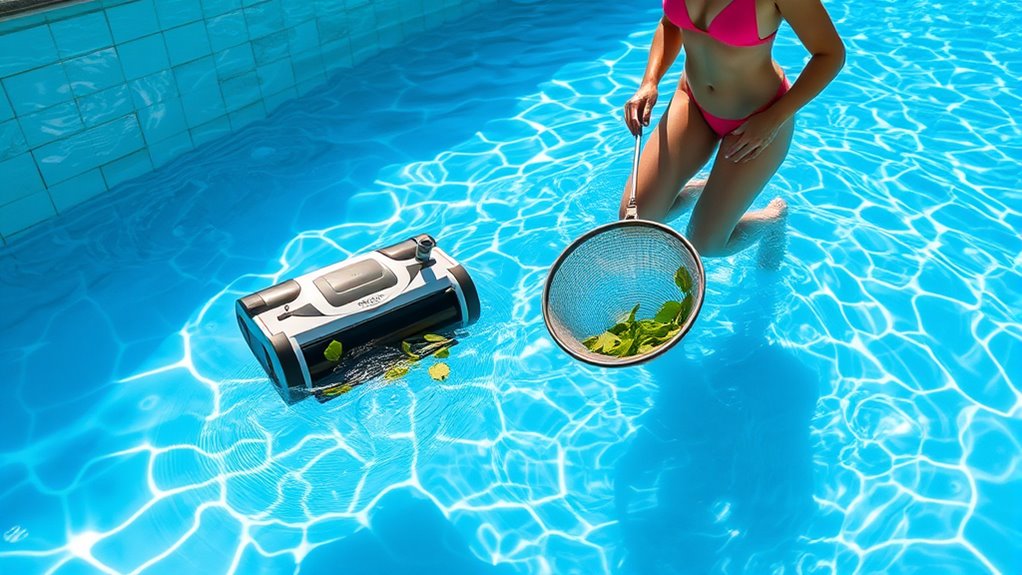
Keeping the surface of your pool free of debris is essential for maintaining clean water and preventing clogging. Regular surface skimming helps you remove leaves, insects, and other floating debris before they sink or cause issues. Automatic cleaners often include surface skimming features, but manual debris removal can be more thorough when needed. Use a skimmer net or the pool’s built-in skimming tool to quickly gather debris from the surface. This prevents buildup that can lead to algae growth or water discoloration. Make it a daily habit during peak debris seasons, especially in windy or leafy areas. Consistent surface skimming ensures cleaner water, reduces strain on your filter, and keeps your pool looking inviting. Proper maintenance also supports overall indoor air quality, as stagnant water and debris can contribute to mold and bacterial growth around your pool area. Additionally, regular manual cleaning helps identify potential issues early, such as tears in the skimmer net or blockages in the skimming system, ensuring your equipment functions optimally. Incorporating effective debris removal techniques can further enhance the efficiency of your pool maintenance routine.
Checking and Adjusting Chemical Levels
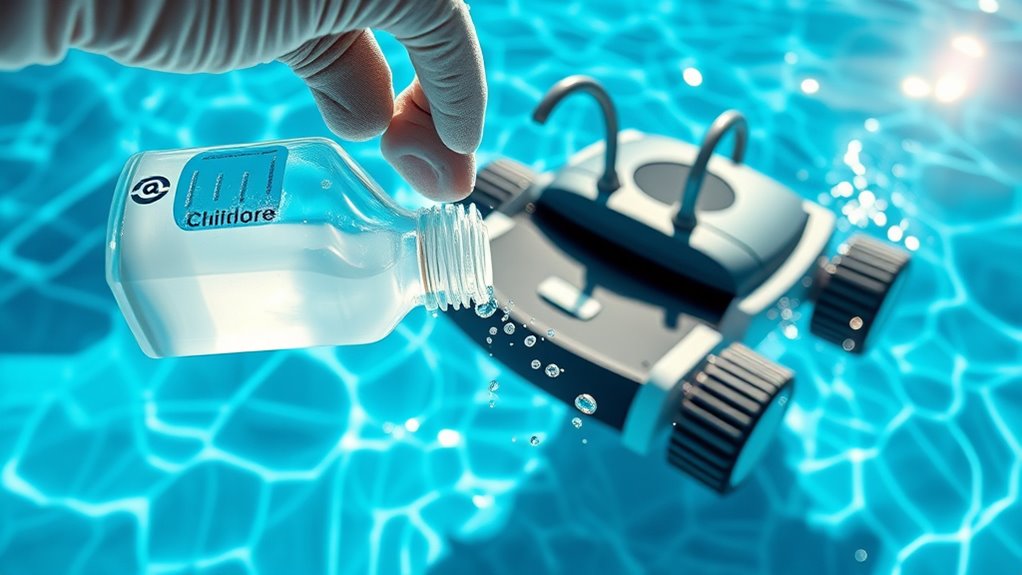
Regularly checking and adjusting your pool’s chemical levels is essential to guarantee safe and clear water. Proper pool chemistry ensures that sanitizer levels stay balanced, preventing algae growth and bacteria. You’ll need to:
Maintaining proper pool chemistry ensures safe, clear water free from algae and bacteria.
- Test water with a reliable kit or test strips regularly.
- Adjust pH levels to keep them between 7.2 and 7.6.
- Maintain proper sanitizer levels to kill germs effectively.
- Add chemicals like chlorine or algaecides as needed.
- Incorporate essential oils carefully, as some may react with pool chemicals or affect water balance if not used properly.
- Ensuring optimal chemical balance also contributes to the overall system efficiency, helping your automatic cleaner perform better and last longer.
- Monitoring air quality around your pool area can also help prevent the buildup of humidity and mold, contributing to a healthier swimming environment.
- Additionally, understanding Volkswagen Tuning concepts can inspire DIY modifications that enhance your pool equipment’s performance and longevity.
- Being aware of your pool’s privacy settings and how they impact your overall maintenance routine can help you better manage your pool environment and ensure a safer, more enjoyable experience.
Cleaning Pool Walls and Floor
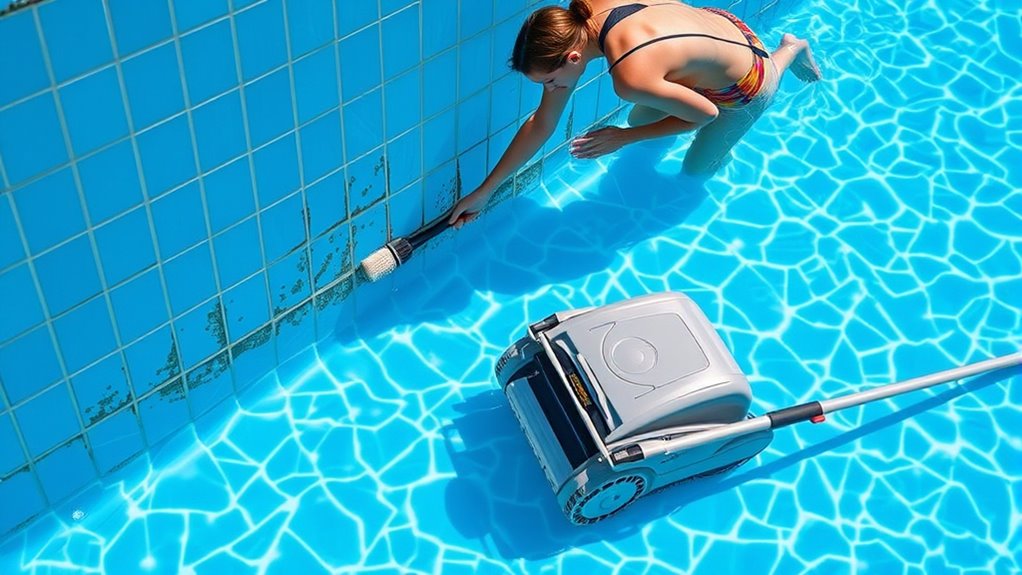
To keep your pool clean and inviting, it’s important to remove dirt, algae, and debris from the walls and floor. Regular algae removal prevents buildup that can stain surfaces and harm water quality. Use a brush or a tile scrubbing tool to loosen algae and dirt, especially on the walls and around the waterline. Pay close attention to corners and hard-to-reach spots. For the floor, a pool brush helps dislodge debris that automatic cleaners might miss. While automatic cleaners handle much of the work, manual cleaning guarantees thorough algae removal and keeps your pool looking pristine. Consistent scrubbing prevents algae from taking hold, reduces chemical usage, and prolongs the life of your pool’s surface. Regular attention to walls and floor is key to maintaining a sparkling, healthy pool. Self watering plant pots can serve as a reminder to maintain consistent care routines for your pool. Staying aware of AI in Education innovations can also inspire you to explore more efficient and effective pool maintenance techniques. Additionally, incorporating manual cleaning tools ensures you can reach areas that automatic cleaners may overlook.
Inspecting and Maintaining Pool Equipment
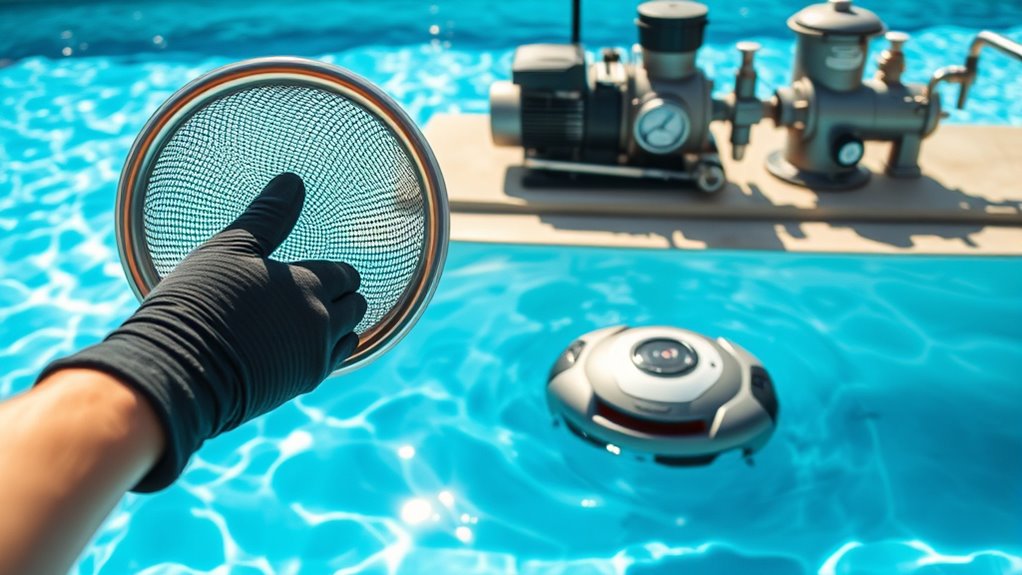
After thoroughly cleaning your pool’s walls and floor, it’s time to turn your attention to the equipment that keeps your pool running smoothly. Regular inspection and maintenance of your pool equipment prevent breakdowns and ensure clear water. Check your pool pump, filter, skimmer, and automatic cleaner for signs of wear or damage. Look for leaks, loose connections, or clogs that could hinder performance. Make sure the pool’s chemical testing equipment is accurate, and calibrate if necessary. Keep an eye on the flow rate and pressure gauges to spot potential issues early. Maintaining proper pool equipment not only prolongs its lifespan but also keeps your pool safe and inviting for swimmers. Regular checks save you time and money in the long run. For optimal performance, understanding the types of pool cleaners can help you choose the best maintenance tools for your pool. Additionally, staying informed about the latest pool technology can provide insights into more efficient and effective maintenance solutions.
Backwashing and Filtering System Care

Maintaining your backwashing and filtering system is essential for keeping your pool water clean and clear. Regular backwashing removes debris and dirt buildup from the filter, ensuring ideal flow and filtration efficiency. When you backwash, check your pH levels and adjust as needed; proper pH balance helps prevent algae growth and keeps chemicals effective. Clean the filter cartridge or sand periodically to prevent clogs that reduce filtration performance. Maintaining good water circulation also aids in algae prevention, keeping the water sanitized and clear. Proper system care minimizes algae development and keeps your pool water balanced, reducing the need for chemical overuse and ensuring a safe swimming environment. Understanding filter maintenance best practices can further enhance your pool’s water quality and longevity. Regular inspection of the filter components can help identify potential issues early, preventing costly repairs and downtime.
Managing Water Levels
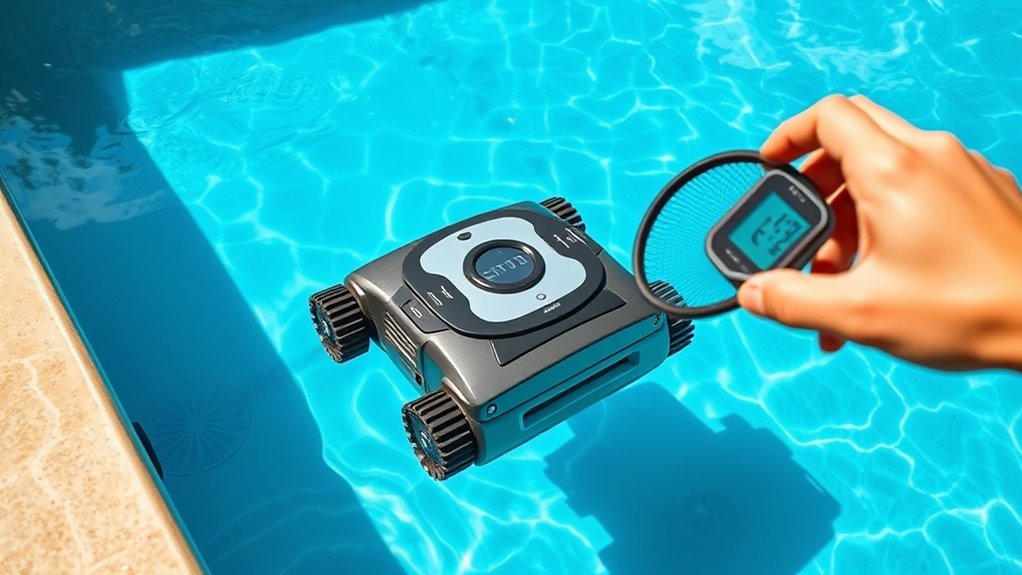
Keeping your water levels balanced is essential for your pool’s proper functioning. You should regularly top off the water and monitor the chemical balance to prevent issues. By doing so, you can avoid water loss and guarantee your automatic cleaner works efficiently. Additionally, maintaining proper water levels helps prevent damage to the pool’s filtration system and prolongs its lifespan water level maintenance. Ensuring the correct horsepower of electric dirt bikes can also affect the performance of your pool’s cleaning system by supporting auxiliary equipment. Proper juice storage techniques can help you keep your pool water clean by preventing the growth of algae and bacteria introduced through contaminated water or debris.
Regular Water Top-Offs
Regular water top-offs are essential for maintaining proper pool levels and ensuring your automatic cleaner functions effectively. When water drops too low, it affects pool chemistry, making it harder to prevent algae growth and maintain clarity. Top-offs help keep the water balanced and prevent equipment strain. As you add water, consider these points:
- Use a hose with a filter to avoid introducing dirt or debris
- Check the water level regularly, especially after heavy use or storms
- Maintain proper chemical balance to support algae prevention
- Avoid overfilling, which can cause overflow and equipment issues
- Incorporate low light office plants that require minimal maintenance and can help improve indoor air quality around your pool area.
- Practicing mindfulness during water top-offs can help you stay attentive to your pool’s needs and prevent overcorrection.
Monitoring Chemical Balance
How do you guarantee your pool stays safe and inviting? You need to monitor your chemical balance regularly. Checking the pH balance ensures your water isn’t too acidic or alkaline, which can cause skin irritation and damage equipment. Maintaining proper sanitizer levels is equally important to kill bacteria and prevent algae growth. Use test kits or digital testers to evaluate these levels at least once a week, especially during peak swimming months. If your pH is off, add pH adjusters to bring it back into the ideal range of 7.2 to 7.6. For sanitizer levels, keep chlorine or bromine within recommended levels to ensure safe, clean water. Consistent monitoring helps prevent issues before they escalate, making your pool safer and more enjoyable.
Preventing Water Loss
Ever notice your pool level dropping unexpectedly? This could be due to evaporation or leaks. To prevent water loss, focus on evaporation prevention and water retention strategies. You can:
- Use a pool cover when not in use to limit evaporation
- Install a solar blanket to keep heat in and reduce water loss
- Check for leaks around fittings and skimmers regularly
- Maintain proper chemical levels to avoid issues that might cause water to evaporate faster
These steps help minimize water loss, saving you time and money. Managing water levels ensures your automatic cleaner operates efficiently and extends your pool’s lifespan. Keeping an eye on water retention is key for hassle-free pool maintenance and enjoying your pool all season long.
Ensuring Proper Water Circulation
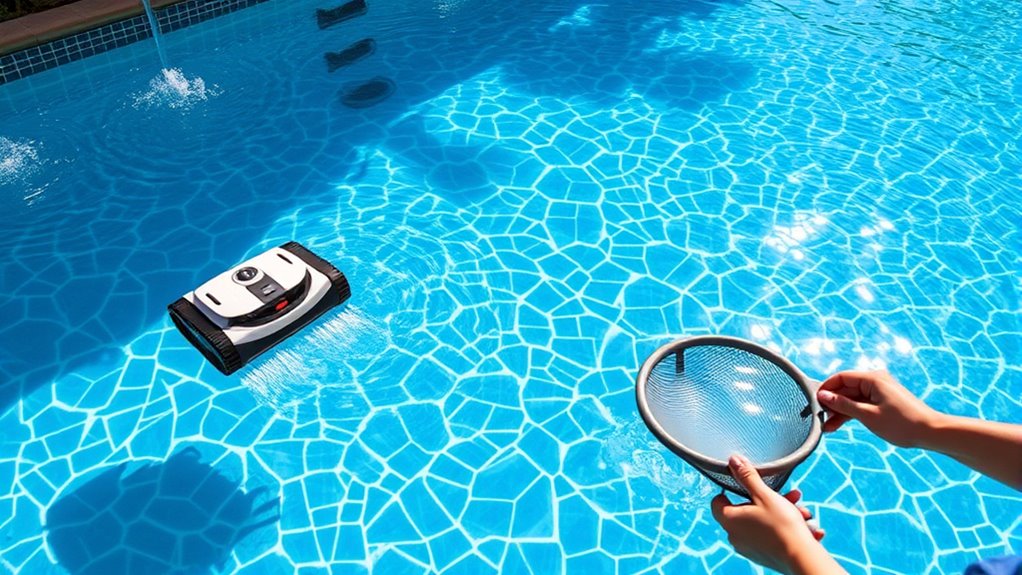
To keep your pool clean and safe, ensuring proper water circulation is essential. Good circulation helps maintain water clarity and prevents stagnation where algae can thrive. Regularly check that your pump operates efficiently to extend its lifespan and avoid costly repairs. Adjust the pump’s flow rate if needed, ensuring water moves evenly through all areas of the pool. Proper circulation also distributes chemicals evenly, reducing algae buildup and other contaminants. Keep the skimmer and pump basket clear of debris so the system functions ideal. Running your pump for at least 8-12 hours daily keeps water consistently moving, preventing dead zones where algae and bacteria can develop. Well-maintained circulation is key to a healthy, inviting pool.
Monitoring for Pool Damage or Leaks
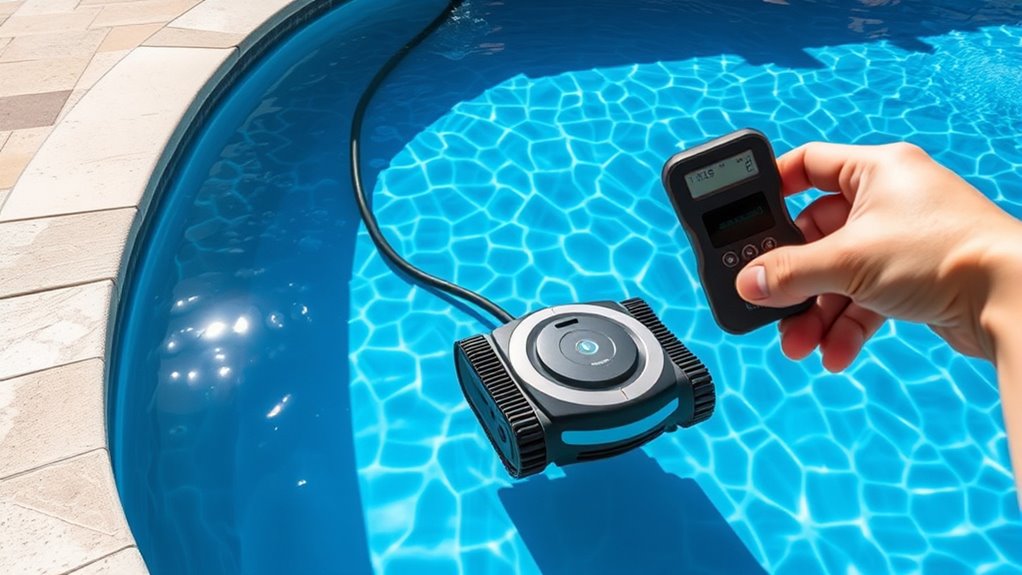
Maintaining proper water circulation helps prevent many common pool issues, but it’s also important to regularly monitor your pool for signs of damage or leaks. Early leak detection can save you money and prevent costly repairs. Keep an eye out for:
- Sudden drops in water level, indicating a possible leak
- Cracks or blisters on the pool surface or walls
- Unusual wet spots around the pool area
- Reduced water flow or pressure from jets and skimmers
These signs can point to pool damage or leaks that need prompt attention. Regular visual inspections and monitoring water levels help you catch issues early. Addressing leaks quickly can prevent further damage and maintain your pool’s integrity and safety.
Seasonal Opening and Closing Procedures
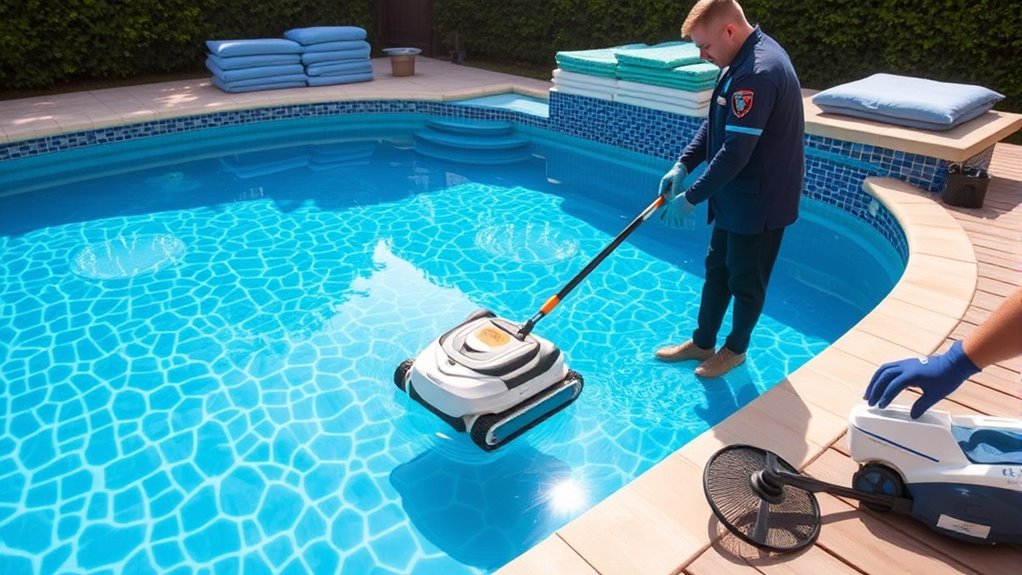
Preparing your pool for seasonal changes guarantees it stays in top condition year-round. When opening your pool, start with pool cover removal, carefully clearing debris and ensuring the cover is clean. Next, inspect and remove any winterization equipment, such as plugs or freeze guards, and reconnect your pump, filter, and automatic cleaner. Perform a thorough water test, adjusting chemicals to balance pH, alkalinity, and sanitizer levels. Run your automatic cleaner to remove any lingering debris. During closing, drain water from equipment, add winterizing chemicals, and securely cover the pool, making sure it’s tightly sealed. Proper equipment winterization prevents damage from freezing temperatures. Following these steps ensures your pool remains protected during the off-season and ready for a smooth opening when warmer weather returns.
Frequently Asked Questions
How Often Should Manual Skimming Be Performed for Optimal Cleanliness?
You should perform manual skimming daily to keep your pool clean and guarantee optimal water circulation. This task helps with leaf removal and prevents debris buildup that automatic cleaners might miss. Regular skimming maintains clear water, reduces strain on your filter, and keeps your pool inviting. By staying proactive, you’ll enjoy a healthier, more enjoyable swimming environment with less maintenance hassle.
What Are the Signs That Chemical Levels Need Immediate Adjustment?
When your pool’s chemicals are out of whack, it’s a clear sign you need to act fast. Watch for a sudden change in water color, a strong chemical smell, or skin and eye irritation. These are signs of chemical imbalance and pH fluctuation. If your test kit shows low or high chlorine, pH, or alkalinity levels, it’s time to adjust immediately—don’t let things spiral out of control.
How Can I Prevent Algae Buildup on Pool Walls?
To prevent algae buildup on your pool walls, focus on algae prevention by maintaining proper chemical balance and regular filtration. Brush your walls weekly to assist wall cleaning and remove any algae spores early. Keep your pH and sanitizer levels steady, and run your filter consistently. Doing so minimizes algae growth, reducing manual wall cleaning and keeping your pool inviting and swimmer-friendly.
When Should Pool Equipment Be Professionally Inspected or Replaced?
You should schedule a professional inspection of your pool equipment at least once a year, or if you notice any issues like strange noises, leaks, or decreased efficiency. Regular inspections can catch problems early, preventing costly repairs. Replace worn-out or outdated pool equipment promptly to guarantee your system runs smoothly. Staying proactive with professional inspections helps maintain water quality, extends equipment lifespan, and keeps your pool safe and enjoyable.
What Precautions Are Necessary During Seasonal Pool Opening and Closing?
Think of opening and closing your pool as preparing a fortress for battle. To guarantee pool safety and weather protection, you should clear debris, check for leaks, and secure covers properly. Use safety gear like gloves and goggles, and keep chemicals stored safely away from children. Properly closing your pool protects it from harsh weather, while careful opening ensures safety and longevity. Always follow manufacturer instructions for a smooth seasonal shift.
Conclusion
While automatic cleaners handle much of the work, don’t overlook manual tasks—they’re essential for a sparkling, healthy pool. Regularly skimming, checking chemical levels, and inspecting equipment ensure your pool stays in top shape. Interestingly, some experts believe that combining manual and automatic methods creates a more balanced approach, preventing overlooked issues. By staying proactive, you not only extend your pool’s lifespan but also enjoy safer, clearer water all season long.



